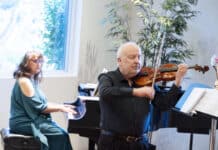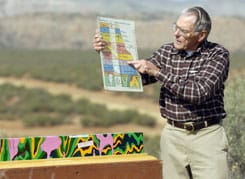Young teenage women in jeans, ponytails and fitted sweaters gathered at Tuzigoot National Monument. They would have probably lost all of their pretty, straight teeth by age 25, if they?d lived there.
Larson Newspapers
________________
Young teenage women in jeans, ponytails and fitted sweaters gathered at Tuzigoot National Monument.
They would have probably lost all of their pretty, straight teeth by age 25, if they?d lived there.
That?s according to Vincent Randall, the director of Apache culture for the Yavapai-Apache Nation.
Shards of stone from eating ground corn and the constant chewing of buckskin for softening purposes really took its toll on ancient women?s teeth, he said.
?In the Southwest, the women were the more important part of society,? he said of ancient civilizations.
Randall, Apache himself, was one of many guest speakers who joined Sedona Red Rock High School humanities students Wednesday, Nov. 1, at Tuzigoot properly pronounced too-zee-woot, according to Randall for an educational field trip.
Students learned about geology, the area?s mining history and the specifics of the ancient Sinagua culture, who are believed to have built the approximately 100-room pueblo atop a hillside near Clarkdale.
One of an estimated 50 major pueblo sites throughout the Verde Valley, Tuzigoot was excavated, stabilized and developed as a national monument by a U.S. Civilian Works Administration crew in the mid-1930s.
On Wednesday, students not only learned the daily tasks of Sinagua women, but also that very serious games of basketball were once played in the area.
In the ancient cultures? version, the games were used to settle wars and often ended up with the loser being sacrificed.
Randall told students how commonalities among some native languages tie certain tribes together such as the Apache and the Navajo.
While Apache speakers can mostly understand Navajo speakers both are Athabascan-speaking peoples some tribal languages are as different as Japanese and German, Randall told students.
Geology consultant Paul Lindberg gave students a graphic representation of how the Verde Valley was formed during the past millennia.
Approximately 8 million years ago, a series of faults split the valley, thrusting up mountains and creating a series of shallow lakes, which then deposited sediments and slowly emptied.
The Verde River once flowed near Tuzigoot, which literally translates into ?crooked water,? according to Randall.
Lindberg pointed across the valley and past a copper mine and smelter to a hillside.
There, he said, archaeologists recently discovered the entire head tusks and all of a wooly mammoth.
?Those animals were living in the area as recently as 11 thousand years,? he said.
?Those animals? were megafauna such as mammoths, ancient camels and horses and giant sloths, now extinct.
Also extinct is the Phelps Dodge Corporation?s copper mine that was once the economic boon of Jerome, now a hilltop artists colony.
Angie Harmon, in public affairs for Phelps Dodge, showed students how the company is voluntarily ?reclaiming? tailings sites near Tuzigoot.
The toxic remnants of copper extraction, disposed of in a large field just outside Clarkdale, are now covered with topsoil and have been seeded with native vegetation.
Soon, Harmon said, the fields should fit in with the nearby landscape.
By the end of the day, students had explored nearly every aspect of Tuzigoot, including the on-site museum. This was part of their ?ancient cultures? curriculum at the high school.
Just one thing, Randall pleaded.
?It?s pronounced ?too-zee-woot.? Not ?too-zee-goot,?? he told students, adding it would make him very happy if they?d correct mispronunciations that they hear.





















